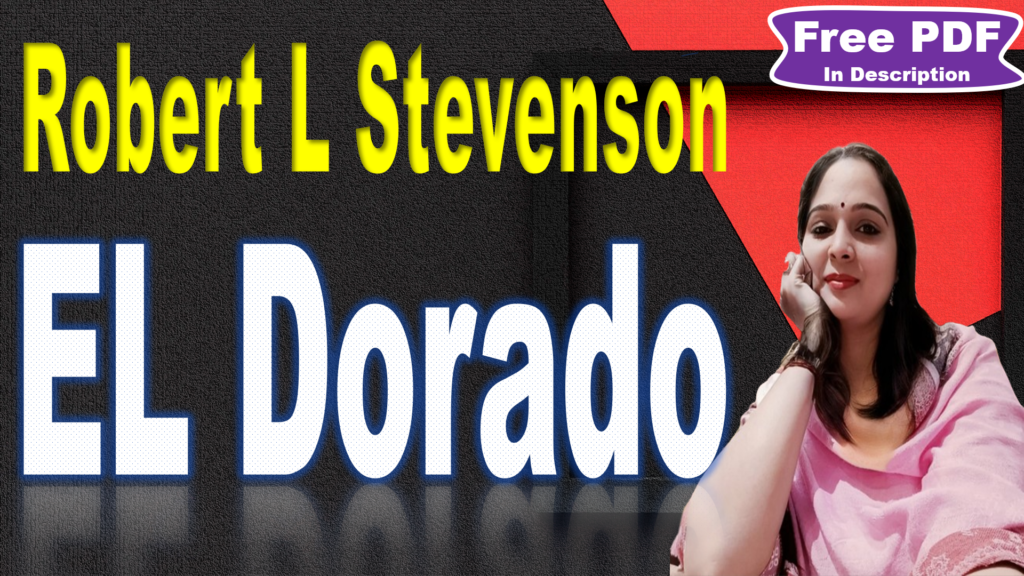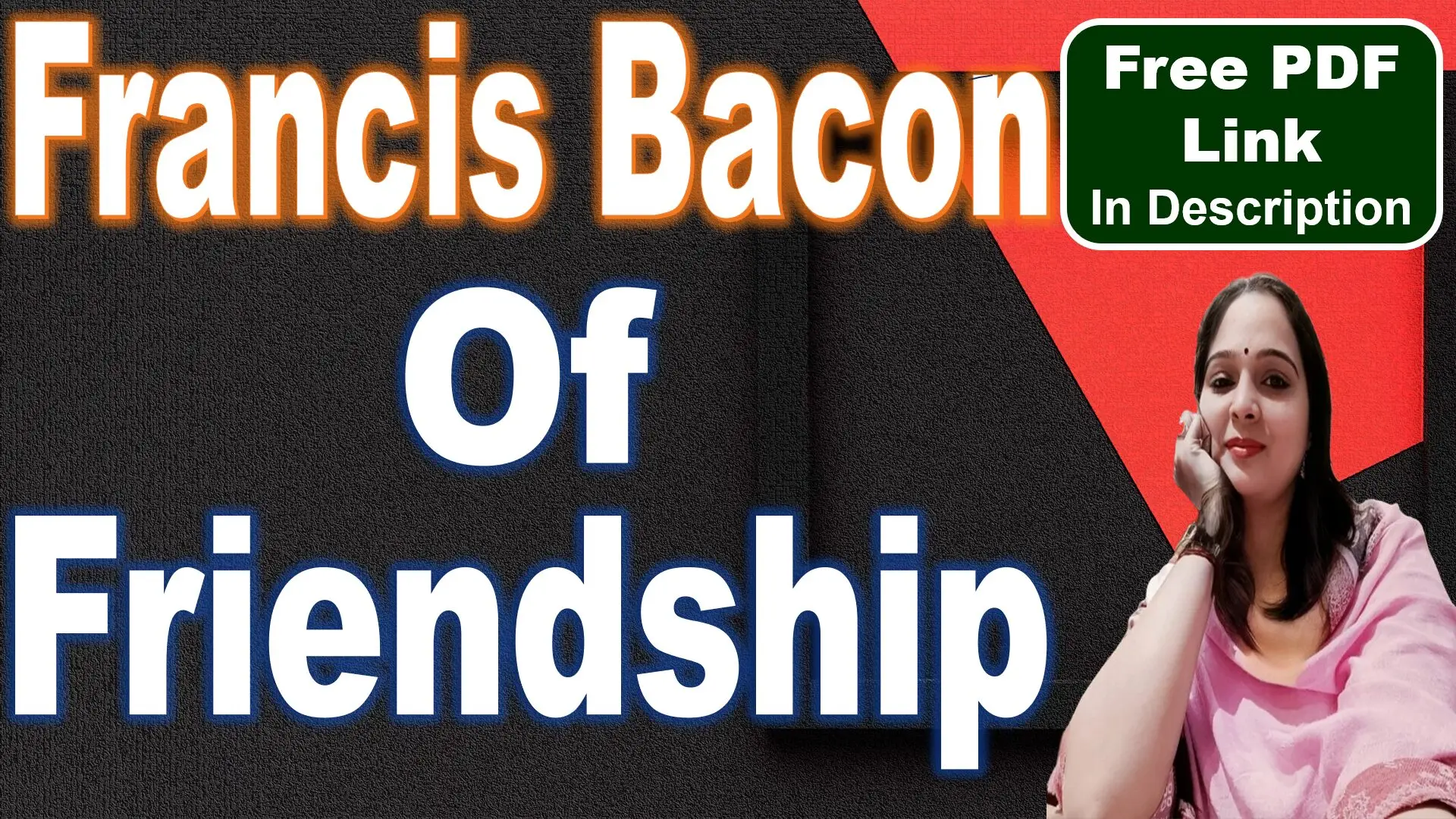
EL Dorado by RL Stevenson | EL Dorado | RL Stevenson | Free Full PDF – Easy Literary Lessons
EL Dorado
IT seems as if a great deal were attainable in a world where there are so many marriages and decisive battles, and where we all, at certain hours of the day, and with great gusto and despatch, stow a portion of victuals finally and irretrievably into the bag which contains us. And it would seem also, on a hasty view, that the attainment of as much as possible was the one goal of man’s contentious life. And yet, as regards the spirit, this is but a semblance. We live in an ascending scale when we live happily, one thing leading to another in an endless series. There is always a new horizon for onward-looking men, and although we dwell on a small planet, immersed in petty business and not enduring beyond a brief period of years, we are so constituted that our hopes are inaccessible, like stars, and the term of hoping is prolonged until the term of life. To be truly happy is a question of how we begin and not of how we end, of what we want and not of what we have. An aspiration is a joy for ever, a possession as solid as a landed estate, a fortune which we can never exhaust and which gives us year by year a revenue of pleasurable activity. To have many of these is to be spiritually rich. Life is only a very dull and ill- directed theatre unless we have some interests in the piece; and to those who have neither art nor science, the world is a mere arrangement of colours, or a rough footway where they may very well break their shins. It is in virtue of his own desires and curiosities that any man continues to exist with even patience, that he is charmed by the look of things and people, and that he wakens every morning with a renewed appetite for work and pleasure. Desire and curiosity are the two eyes through which he sees the world in the most enchanted colours: it is they that make women beautiful or fossils interesting: and the man may squander his estate and come to beggary, but if he keeps these two amulets he is still rich in the possibilities of pleasure. Suppose he could take one meal so compact and comprehensive that he should never hunger any more; suppose him, at a glance, to take in all the features of the world and allay the desire for knowledge; suppose him to do the like in any province of experience – would not that man be in a poor way for amusement ever after?
One who goes touring on foot with a single volume in his knapsack reads with circumspection, pausing often to reflect, and often laying the book down to contemplate the landscape or the prints in the inn parlour; for he fears to come to an end of his entertainment, and be left companionless on the last stages of his journey. A young fellow recently finished the works of Thomas Carlyle, winding up, if we remember aright, with the ten note-books upon Frederick the Great. “What!” cried the young fellow, in consternation, “is there no more Carlyle? Am I left to the daily papers?” A more celebrated instance is that of Alexander, who wept bitterly because he had no more worlds to subdue. And when Gibbon had finished the DECLINE AND FALL, he had only a few moments of joy; and it was with a “sober melancholy” that he parted from his labours.
Happily we all shoot at the moon with ineffectual arrows; our hopes are set on inaccessible El Dorado; we come to an end of nothing here below. Interests are only plucked up to sow themselves again, like mustard. You would think, when the child was born, there would be an end to trouble; and yet it is only the beginning of fresh anxieties; and when you have seen it through its teething and its education, and at last its marriage, alas! it is only to have new fears, new quivering sensibilities, with every day; and the health of your children’s children grows as touching a concern as that of your own. Again, when you have married your wife, you would think you were got upon a hilltop, and might begin to go downward by an easy slope. But you have only ended courting to begin marriage. Falling in love and winning love are often difficult tasks to overbearing and rebellious spirits; but to keep in love is also a business of some importance, to which both man and wife must bring kindness and goodwill. The true love story commences at the altar, when there lies before the married pair a most beautiful contest of wisdom and generosity, and a life-long struggle towards an unattainable ideal. Unattainable? Ay, surely unattainable, from the very fact that they are two instead of one.
“Of making books there is no end,” complained the Preacher; and did not perceive how highly he was praising letters as an occupation. There is no end, indeed, to making books or experiments, or to travel, or to gathering wealth. Problem gives rise to problem. We may study for ever, and we are never as learned as we would. We have never made a statue worthy of our dreams. And when we have discovered a continent, or crossed a chain of mountains, it is only to find another ocean or another plain upon the further side. In the infinite universe there is room for our swiftest diligence and to spare. It is not like the works of Carlyle, which can be read to an end. Even in a corner of it, in a private park, or in the neighbourhood of a single hamlet, the weather and the seasons keep so deftly changing that although we walk there for a lifetime there will be always something new to startle and delight us. There is only one wish realisable on the earth; only one thing that can be perfectly attained: Death. And from a variety of circumstances we have no one to tell us whether it be worth attaining.
A strange picture we make on our way to our chimaeras, ceaselessly marching, grudging ourselves the time for rest; indefatigable, adventurous pioneers. It is true that we shall never reach the goal; it is even more than probable that there is no such place; and if we lived for centuries and were endowed with the powers of a god, we should find ourselves not much nearer what we wanted at the end. O toiling hands of mortals! O unwearied feet, travelling ye know not whither! Soon, soon, it seems to you, you must come forth on some conspicuous hilltop, and but a little way further, against the setting sun, descry the spires of El Dorado. Little do ye know your own blessednes; for to travel hopefully is a better thing than to arrive, and the true success is to labour.
Summary
The essay begins with Stevenson reflecting on the human condition, our desires, aspirations, and the pursuit of knowledge. He suggests that our desires and curiosities are what make life interesting and worth living. This is a profound observation about the human spirit and our innate curiosity. We are driven by our desires and aspirations, and these are the things that give our lives meaning and purpose. They are the fuel that drives us to learn, to explore, and to strive for more.
Stevenson argues that the joy of life comes not from attaining everything we want, but from the ongoing pursuit of our aspirations. This is a powerful statement about the nature of happiness and fulfillment. It’s not the attainment of our goals that brings us joy, but the journey towards them. The process of striving, of overcoming challenges, of learning and growing – these are the things that bring us joy.
The text also highlights the importance of continuous learning and the joy of discovery. Even when we think we have learned all there is to know about a subject, there is always more to discover. This speaks to the infinite nature of knowledge and the human capacity for learning. No matter how much we learn, there is always more to discover, and this ongoing journey of discovery is what makes life rich and fulfilling.
Stevenson also explores the complexities of life stages such as birth, education, marriage, and parenthood. He suggests that each stage, while appearing to be a culmination, is actually the beginning of a new set of challenges and anxieties. This is a poignant observation about the cyclical nature of life. Each stage of life brings its own challenges and rewards, and each stage is a stepping stone to the next.
Stevenson emphasizes the importance of kindness and goodwill in maintaining love in a marriage, and describes it as a lifelong struggle towards an unattainable ideal. This is a beautiful and realistic portrayal of marriage. It’s not just about falling in love and getting married, it’s about maintaining that love through kindness and goodwill. It’s about striving towards an ideal, even if it’s unattainable.
Stevenson then turns to the endless nature of human pursuits such as writing, learning, traveling, and wealth accumulation. He suggests that every achievement or discovery only leads to new challenges and further quests. This is a profound observation about the nature of human achievement. Every achievement is just a stepping stone to the next challenge, and every discovery opens up new avenues for exploration.
Towards the end of the essay, Stevenson states that the only certainty in life is death, and even then, we do not know if it is worth attaining. This is a sobering reminder of our mortality, and the ultimate uncertainty of life.
He portrays humans as ceaseless pioneers, always striving towards their dreams, even though they may never reach them. He ends on a hopeful note, suggesting that the journey itself, rather than the destination, is what brings fulfillment and that true success lies in the effort we put into our endeavors. This is a powerful message about the value of the journey over the destination, and the importance of effort and perseverance.
In conclusion, Stevenson’s essay is a profound meditation on the nature of human aspiration, the value of the journey over the destination, and the importance of effort and perseverance. It encourages us to appreciate the process of striving for our goals, even if they seem unattainable, and to find joy in the journey, rather than the destination. It’s a powerful and thought-provoking piece that offers valuable insights into the human condition.
निबंध की शुरुआत स्टीवेन्सन द्वारा मानवीय स्थिति, हमारी इच्छाओं, आकांक्षाओं और ज्ञान की खोज पर चिंतन से होती है। उनका सुझाव है कि हमारी इच्छाएँ और जिज्ञासाएँ ही जीवन को रोचक और जीने लायक बनाती हैं। यह मानवीय भावना और हमारी सहज जिज्ञासा के बारे में एक गहन अवलोकन है। हम अपनी इच्छाओं और आकांक्षाओं से प्रेरित होते हैं, और यही चीजें हैं जो हमारे जीवन को अर्थ और उद्देश्य देती हैं। वे वह ईंधन हैं जो हमें सीखने, अन्वेषण करने और और अधिक के लिए प्रयास करने के लिए प्रेरित करते हैं।
स्टीवेन्सन का तर्क है कि जीवन का आनंद वह सब कुछ प्राप्त करने से नहीं है जो हम चाहते हैं, बल्कि हमारी आकांक्षाओं की निरंतर पूर्ति से आता है। यह खुशी और संतुष्टि की प्रकृति के बारे में एक शक्तिशाली कथन है। यह हमारे लक्ष्यों की प्राप्ति नहीं है जो हमें खुशी देती है, बल्कि उनकी ओर यात्रा है। प्रयास करने की प्रक्रिया, चुनौतियों पर काबू पाने की प्रक्रिया, सीखने और बढ़ने की – ये ऐसी चीजें हैं जो हमें खुशी देती हैं।
पाठ निरंतर सीखने के महत्व और खोज की खुशी पर भी प्रकाश डालता है। यहां तक कि जब हम सोचते हैं कि हमने किसी विषय के बारे में जानने लायक सब कुछ सीख लिया है, तब भी खोजने के लिए हमेशा कुछ न कुछ होता है। यह ज्ञान की अनंत प्रकृति और सीखने की मानवीय क्षमता की बात करता है। इससे कोई फर्क नहीं पड़ता कि हम कितना कुछ सीखते हैं, खोजने के लिए हमेशा कुछ न कुछ होता है और खोज की यह सतत यात्रा ही जीवन को समृद्ध और संतुष्टिदायक बनाती है।
स्टीवेन्सन जन्म, शिक्षा, विवाह और पितृत्व जैसे जीवन चरणों की जटिलताओं का भी पता लगाते हैं। उनका सुझाव है कि प्रत्येक चरण, एक चरमोत्कर्ष प्रतीत होते हुए, वास्तव में चुनौतियों और चिंताओं के एक नए समूह की शुरुआत है। यह जीवन की चक्रीय प्रकृति के बारे में एक मार्मिक अवलोकन है। जीवन का प्रत्येक चरण अपनी चुनौतियाँ और पुरस्कार लाता है, और प्रत्येक चरण अगले चरण की ओर एक कदम है।
स्टीवेन्सन विवाह में प्रेम बनाए रखने में दयालुता और सद्भावना के महत्व पर जोर देते हैं, और इसे एक अप्राप्य आदर्श के लिए आजीवन संघर्ष के रूप में वर्णित करते हैं। यह विवाह का सुन्दर एवं यथार्थवादी चित्रण है। यह सिर्फ प्यार में पड़ने और शादी करने के बारे में नहीं है, यह दयालुता और सद्भावना के माध्यम से उस प्यार को बनाए रखने के बारे में है। यह एक आदर्श की ओर प्रयास करने के बारे में है, भले ही वह अप्राप्य हो।
इसके बाद स्टीवेन्सन लेखन, सीखने, यात्रा और धन संचय जैसी मानवीय गतिविधियों की अंतहीन प्रकृति की ओर मुड़ते हैं। उनका सुझाव है कि प्रत्येक उपलब्धि या खोज केवल नई चुनौतियों और आगे की खोजों की ओर ले जाती है। यह मानव उपलब्धि की प्रकृति के बारे में एक गहन अवलोकन है। प्रत्येक उपलब्धि अगली चुनौती के लिए एक कदम मात्र है, और प्रत्येक खोज अन्वेषण के लिए नए रास्ते खोलती है।
निबंध के अंत में, स्टीवेन्सन कहते हैं कि जीवन में एकमात्र निश्चितता मृत्यु है, और फिर भी, हम नहीं जानते कि क्या यह प्राप्त करने लायक है। यह हमारी नश्वरता और जीवन की अंतिम अनिश्चितता का एक गंभीर अनुस्मारक है।
वह इंसानों को निरंतर अग्रदूतों के रूप में चित्रित करता है, जो हमेशा अपने सपनों की ओर प्रयास करते हैं, भले ही वे उन तक कभी नहीं पहुंच पाते। वह एक उम्मीद भरे नोट पर समाप्त होता है, जिसमें सुझाव दिया गया है कि मंजिल के बजाय यात्रा ही पूर्णता लाती है और सच्ची सफलता हमारे प्रयासों में निहित है। यह गंतव्य पर यात्रा के मूल्य, और प्रयास और दृढ़ता के महत्व के बारे में एक शक्तिशाली संदेश है।
अंत में, स्टीवेन्सन का निबंध मानव आकांक्षा की प्रकृति, गंतव्य पर यात्रा के मूल्य और प्रयास और दृढ़ता के महत्व पर गहरा ध्यान है। यह हमें अपने लक्ष्यों के लिए प्रयास करने की प्रक्रिया की सराहना करने के लिए प्रोत्साहित करता है, भले ही वे अप्राप्य लगते हों, और गंतव्य के बजाय यात्रा में आनंद खोजने के लिए प्रोत्साहित करते हैं। यह एक शक्तिशाली और विचारोत्तेजक कृति है जो मानवीय स्थिति के बारे में बहुमूल्य अंतर्दृष्टि प्रदान करती है।
Key Points
Author
Robert Louis Stevenson was a Scottish novelist, poet, and travel writer, most noted for his works “Treasure Island”, “Kidnapped”, and “Strange Case of Dr Jekyll and Mr Hyde”. He was a master of many genres and his work has been admired by many other writers.
Introduction
“El Dorado” is an essay by Stevenson that explores the human condition, our desires, aspirations, and the pursuit of knowledge. The title “El Dorado” refers to the legendary city of gold, which symbolizes the unattainable goals that humans continuously strive for.
Structure
The essay is structured as a continuous piece of prose, without any distinct sections or chapters. It flows from one idea to the next, with each paragraph building on the previous one. The essay begins with a reflection on human desires and aspirations, then explores the complexities of life stages such as birth, education, marriage, and parenthood, and concludes with a meditation on the nature of human achievement and the value of the journey over the destination.
Setting
The essay does not have a specific physical setting as it is a philosophical and introspective piece. The “setting” could be considered as the inner landscape of human experience and aspiration.
Theme
The main theme of the essay is the human pursuit of happiness, knowledge, and fulfillment. Stevenson suggests that our desires and curiosities are what make life interesting and worth living, and that the joy of life comes not from attaining everything we want, but from the ongoing pursuit of our aspirations. He also explores the complexities of life stages and the endless nature of human pursuits.
Style
Stevenson’s style in this essay is reflective and philosophical. He uses rich, evocative language and employs metaphors and analogies to illustrate his points. His writing is both profound and accessible, making complex ideas understandable and relatable.
Message
The overarching message of the essay is that the journey itself, rather than the destination, is what brings fulfillment and that true success lies in the effort we put into our endeavors. Stevenson encourages us to appreciate the process of striving for our goals, even if they seem unattainable. He suggests that our desires and curiosities are what make life interesting and worth living, and that the joy of life comes not from attaining everything we want, but from the ongoing pursuit of our aspirations.
Robert Louis Stevenson
Introduction
Robert Louis Stevenson was a Scottish novelist, poet, essayist, and travel writer. He is best known for his works such as “Treasure Island”, “Strange Case of Dr Jekyll and Mr Hyde”, “Kidnapped” and “A Child’s Garden of Verses”.
Early Life and Education
Stevenson was born on November 13, 1850, in Edinburgh, Scotland. His father, Thomas Stevenson, was a leading lighthouse engineer, and his mother was Margaret Isabella Balfour1. Despite suffering from serious bronchial trouble for much of his life, Stevenson was educated in Edinburgh and showed a desire to write early in life.
Career and Major Works
Stevenson’s career as a writer spanned a variety of genres. His novels, such as “Treasure Island” and “Strange Case of Dr Jekyll and Mr Hyde”, are considered classics of English literature. He also wrote essays and travel books, reflecting his wide-ranging interests and experiences.
Personal Life
Stevenson married Fanny Van de Grift Osbourne and they had a stepson, Lloyd Osbourne. Despite his poor health, Stevenson traveled widely and eventually settled in Samoa.
Later Life and Death
In his later years, Stevenson’s writing turned from romance and adventure fiction towards a darker realism. He died of a stroke in his island home in Samoa on December 3, 1894, at the age of 44.
Legacy
Stevenson’s work has had a significant impact on English literature. His novels have been widely read and adapted for stage and screen. His critical reputation has fluctuated since his death, but today his works are held in general acclaim.
Influence
Stevenson’s influence extends beyond literature. His exploration of human nature and the duality of good and evil in “Strange Case of Dr Jekyll and Mr Hyde” has had a lasting impact on popular culture. His works continue to be studied and appreciated for their literary merit and their insightful commentary on the human condition.
Very Short Answer Questions
Q: Who is the author of the essay “El Dorado”?
A: The author of “El Dorado” is Robert Louis Stevenson.
Q: What does “El Dorado” symbolize in the essay?
A: In the essay, “El Dorado” symbolizes the unattainable goals that humans continuously strive for.
Q: What is the main theme of the essay?
A: The main theme of the essay is the human pursuit of happiness, knowledge, and fulfillment.
Q: What does Stevenson suggest about human desires and curiosities?
A: Stevenson suggests that our desires and curiosities are what make life interesting and worth living.
Q: According to Stevenson, what brings joy in life?
A: According to Stevenson, the joy of life comes not from attaining everything we want, but from the ongoing pursuit of our aspirations.
Q: What does Stevenson say about the complexities of life stages?
A: Stevenson suggests that each life stage, while appearing to be a culmination, is actually the beginning of a new set of challenges and anxieties.
Q: What does Stevenson emphasize about maintaining love in a marriage? A: Stevenson emphasizes the importance of kindness and goodwill in maintaining love in a marriage.
Q: What does Stevenson say about human pursuits such as writing, learning, traveling, and wealth accumulation?
A: Stevenson suggests that every achievement or discovery only leads to new challenges and further quests.
Q: What is the only certainty in life according to Stevenson?
A: According to Stevenson, the only certainty in life is death.
Q: How does Stevenson portray humans?
A: Stevenson portrays humans as ceaseless pioneers, always striving towards their dreams, even though they may never reach them.
Q: What is the hopeful note that Stevenson ends the essay on?
A: Stevenson ends on a hopeful note, suggesting that the journey itself, rather than the destination, is what brings fulfillment and that true success lies in the effort we put into our endeavors.
Q: What does Stevenson encourage us to appreciate?
A: Stevenson encourages us to appreciate the process of striving for our goals, even if they seem unattainable.
Q: What does Stevenson say about the value of the journey over the destination?
A: Stevenson suggests that the journey itself, rather than the destination, is what brings fulfillment.
Q: What does Stevenson say about true success?
A: According to Stevenson, true success lies in the effort we put into our endeavors.
Q: What does Stevenson say about the nature of happiness and fulfillment? A: Stevenson suggests that it’s not the attainment of our goals that brings us joy, but the journey towards them.
Q: What does Stevenson say about the infinite nature of knowledge?
A: Stevenson suggests that no matter how much we learn, there is always more to discover.
Q: What does Stevenson say about the cyclical nature of life?
A: Stevenson suggests that each stage of life brings its own challenges and rewards, and each stage is a stepping stone to the next.
Q: What does Stevenson say about the nature of human achievement?
A: Stevenson suggests that every achievement is just a stepping stone to the next challenge.
Q: What does Stevenson say about the ultimate uncertainty of life?
A: Stevenson suggests that even death, the only certainty in life, is ultimately uncertain as we do not know if it is worth attaining.
Q: What is the overarching message of the essay?
A: The overarching message of the essay is that the journey itself, rather than the destination, is what brings fulfillment and that true success lies in the effort we put into our endeavors.
Short Answer Questions
Q: What is the central theme of Robert Louis Stevenson’s essay “El Dorado”?
A: The central theme of “El Dorado” is the human pursuit of happiness, knowledge, and fulfillment. Stevenson suggests that our desires and curiosities are what make life interesting and worth living, and that the joy of life comes not from attaining everything we want, but from the ongoing pursuit of our aspirations.
Q: How does Stevenson use the metaphor of “El Dorado” in his essay?
A: Stevenson uses “El Dorado” as a metaphor for the unattainable goals that humans continuously strive for. It symbolizes the endless pursuit of happiness, knowledge, and success, which, according to Stevenson, is the essence of life.
Q: What does Stevenson suggest about the nature of human desires and aspirations?
A: Stevenson suggests that our desires and aspirations are continually renewed, like mustard seeds that are sown again after they are harvested. He emphasizes that it’s not the attainment of our goals that brings us joy, but the journey towards them.
Q: How does Stevenson portray the complexities of life stages such as birth, education, marriage, and parenthood?
A: Stevenson suggests that each life stage, while appearing to be a culmination, is actually the beginning of a new set of challenges and anxieties. He emphasizes the importance of kindness and goodwill in maintaining love in a marriage, and describes it as a lifelong struggle towards an unattainable ideal.
Q: What does Stevenson say about the endless nature of human pursuits such as writing, learning, traveling, and wealth accumulation?
A: Stevenson suggests that every achievement or discovery only leads to new challenges and further quests. He contrasts this with the works of Carlyle, which can be read to an end, implying that life and its experiences are infinite and ever-changing.
Q: What is the only certainty in life according to Stevenson?
A: According to Stevenson, the only certainty in life is death. However, even then, we do not know if it is worth attaining.
Q: How does Stevenson portray humans in his essay?
A: Stevenson portrays humans as ceaseless pioneers, always striving towards their dreams, even though they may never reach them. He suggests that our desires and curiosities are what make life interesting and worth living.
Q: What is the hopeful note that Stevenson ends the essay on?
A: Stevenson ends on a hopeful note, suggesting that the journey itself, rather than the destination, is what brings fulfillment and that true success lies in the effort we put into our endeavors.
Q: What does Stevenson encourage us to appreciate in his essay?
A: Stevenson encourages us to appreciate the process of striving for our goals, even if they seem unattainable. He suggests that the journey of life and the pursuit of our goals bring more joy and fulfillment than their attainment.
Q: What is the overarching message of the essay “El Dorado”?
A: The overarching message of the essay is that the journey itself, rather than the destination, is what brings fulfillment and that true success lies in the effort we put into our endeavors. It encourages us to appreciate the process of striving for our goals, even if they seem unattainable.
Essay Type Questions
Q: What is the significance of the title of essay “EL Dorado”?
A: “El Dorado” is a term that originates from a legend about a city or a man (also known as “The Gilded One”) of great wealth and prosperity in South America, which explorers sought for many centuries. It has come to symbolize an ultimate prize or “Holy Grail” that is sought after, even though it may be unattainable.
In the context of Robert Louis Stevenson’s essay, “El Dorado” represents the unattainable ideals, dreams, and aspirations that humans continuously strive for. It symbolizes the endless pursuit of happiness, knowledge, and success, which, according to Stevenson, is the essence of life. The title “El Dorado” encapsulates the theme of the essay, which is about the human condition, our desires, aspirations, and the pursuit of knowledge. It suggests that our desires and curiosities are what make life interesting and worth living, and that the joy of life comes not from attaining everything we want, but from the ongoing pursuit of our aspirations.
Stevenson uses “El Dorado” as a metaphor to illustrate the human tendency to strive for unattainable goals. He suggests that our interests and desires are continually renewed, like mustard seeds that are sown again after they are harvested. He emphasizes the importance of kindness and goodwill in maintaining love in a marriage, and describes it as a lifelong struggle towards an unattainable ideal.
So, the title “El Dorado” is significant as it encapsulates the central theme of the essay – the endless human pursuit of happiness, knowledge, and fulfillment, and the value of the journey over the destination.
Write the critical appreciation of the Essay.
Overview
Robert Louis Stevenson’s essay “El Dorado” is a profound and thought-provoking piece that explores the human condition, our desires, aspirations, and the pursuit of knowledge. It is a philosophical meditation on the nature of human aspiration and the value of the journey over the destination. The essay provides a deep insight into the human spirit and our innate curiosity, making it a timeless piece of literature.
Themes and Ideas
The central theme of the essay is the human pursuit of happiness, knowledge, and fulfillment. Stevenson suggests that our desires and curiosities are what make life interesting and worth living. This theme is explored through various metaphors and analogies, making the essay a rich tapestry of ideas and reflections. The essay also delves into the complexities of life stages such as birth, education, marriage, and parenthood, and the endless nature of human pursuits such as writing, learning, traveling, and wealth accumulation.
Use of Metaphor
Stevenson uses the metaphor of “El Dorado”, a legendary city of gold, to symbolize the unattainable goals that humans continuously strive for. This metaphor effectively illustrates the endless pursuit of happiness, knowledge, and success, which, according to Stevenson, is the essence of life. The use of this metaphor adds a layer of depth to the essay, making it a rich and engaging read.
Style and Language
Stevenson’s style in this essay is reflective and philosophical. He uses rich, evocative language and employs metaphors and analogies to illustrate his points. His writing is both profound and accessible, making complex ideas understandable and relatable. The language used in the essay is beautiful and evocative, painting a vivid picture of the human condition and our endless pursuit of knowledge and fulfillment.
Message
The overarching message of the essay is that the journey itself, rather than the destination, is what brings fulfillment and that true success lies in the effort we put into our endeavors. It encourages us to appreciate the process of striving for our goals, even if they seem unattainable. This message is a powerful reminder of the value of the journey over the destination, and the importance of effort and perseverance in the pursuit of our goals.
Conclusion
In conclusion, “El Dorado” is a masterful essay that offers valuable insights into the human condition and the nature of aspiration. It is a testament to Stevenson’s skill as a writer and his deep understanding of human nature. The essay is a powerful reminder of the value of the journey over the destination, and the importance of effort and perseverance in the pursuit of our goals. It is a work that continues to resonate with readers today, offering timeless wisdom and inspiration.
Write long note on Robert Louis Stevenson as Essayist.
Introduction
Robert Louis Stevenson, a Scottish novelist, poet, and travel writer, was also a prolific essayist. His essays were widely considered the best of their time, known for their intellectual substance, emotional force, and stylistic vitality. He was a master of many genres and his work has been admired by many other writers.
Early Career
Stevenson began his career primarily as an essayist and travel writer. His early works were marked by a distinctive style that combined intellectual rigor with emotional depth. His essays were characterized by their insightful observations, eloquent prose, and a keen understanding of human nature. He had a unique ability to delve into complex ideas and present them in an accessible and engaging manner.
Transition to Fiction
Although Stevenson started his writing career as an essayist, he soon moved on to short fiction. After the publication of “Treasure Island” in 1883, the novel became his preferred form. However, his background as an essayist greatly influenced his fiction writing, lending depth and complexity to his characters and plots.
Style and Themes
Stevenson’s essays are known for their intellectual substance, emotional force, and stylistic vitality. He had a unique ability to delve into complex ideas and present them in an accessible and engaging manner. His essays often explored themes such as the human condition, our desires, aspirations, and the pursuit of knowledge. These themes are intricately woven into the narrative, providing a comprehensive exploration of the human condition.
Legacy
Despite his transition to fiction, many of Stevenson’s contemporaries thought of him primarily as an essayist. His essays continue to be celebrated for their depth of thought, eloquence, and insight into the human condition. They remain a testament to Stevenson’s skill as a writer and his deep understanding of human nature.
In conclusion, Robert Louis Stevenson was a masterful essayist whose works continue to resonate with readers today. His essays, characterized by their intellectual depth, emotional resonance, and stylistic vitality, offer valuable insights into the human condition and the nature of aspiration. They are a testament to Stevenson’s skill as a writer and his deep understanding of human nature. The essay’s exploration of the human condition, its insightful observations, and its eloquent prose make it a standout piece in Stevenson’s body of work.
Free Full PDF Download Now Click Here





